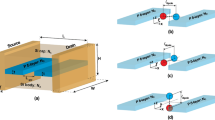Abstract
We give an overview of the open-boundary planar supercell stack method (OPSSM), as a means for treating 3D quantum transport in mesoscopic tunnel structures. The flexibility of the method allows us to examine a variety of physical phenomena relevant to quantum transport. In this work we focus on the effects of interface roughness and embedded nanostructures in tunnel devices. Four representative applications of OPSSM are discussed: (1) interface roughness in double barrier resonant tunneling structures, (2) self-organized InAs quantum dot insertions in GaAs/AlAs double barrier structures, (3) tunneling characteristics of ultra-thin oxides with interface roughness, and, (4) embedded quantum wire model of dielectric breakdown. These examples demonstrate scattering and localization effects under different biasing conditions.
Similar content being viewed by others
References
R. Tsu and L. Esaki, Appl. Phys. Lett. 22, 562 (1973).
S. K. Kirby, D. Z.-Y. Ting, and T. C. McGill, Phys. Rev. B, 48(20), 15237 (1993).
D. Z.-Y. Ting, S.K. Kirby, and T.C. McGill, Appl. Phys. Lett., 64(15), 2004 (1994).
D.Z.-Y. Ting and T.C. McGill, J. Vac. Sci. Technol. B14(4), 2790 (1996).
S. K. Kirby, D. Z.-Y Ting, and T. C. McGill, Semicond. Sci. Tech. 9(5) Suppl. S, 918 (1994).
J.N. Wang, R.G. Li, Y.Q. Wang, W.K. Ge, D. Z.-Y. Ting, Microelectron Eng 43–4 1998, 341–347.
D.Z.-Y Ting, Appl Phys. Lett. 73(19), 2769 (1998).
D. Z.-Y. Ting, Appl. Phys. Lett. 74(4), 585 (1999).
D. Z.-Y. Ting, S. K. Kirby, and T. C. McGill, J. Vac. Sci. Technol. B 11(4), 1738 (1993)
D. J. BenDaniel and C. B. Duke, Phys. Rev., 152, 683 (1966).
D.Z.-Y Ting, E.T. Yu, and T.C. McGill, Phys. Rev. B, 45(7), 3583 (1992)
R.W. Freund and N.M. Nachtigal, Numer Math., 60(3), 315 (1991).
N.Y. Chen, Three-dimensional supercell simulations of quantum transport in a magnetic field, Master degree thesis, National Tsing Hua University, Hsinchu, Taiwan, 1998.
N. Metropolis, A. Rosenbluth, M.N. Rosenbluth, A. Teller, and E. Teller, J. Chem. Phys., 21, 1087 (1953).
S. T. Cundiff et al., Appl. Phys. Lett. 70, 1414(1997).
R. Sugino, T. Nakanishi, K. Takasaki, and T. Ito, J. Electrochem. Soc. 143, 2691 (1996).
Acknowledgments
We give an overview of the open-boundary planar supercell stack method (OPSSM), as a means for treating 3D quantum transport in mesoscopic tunnel structures. The flexibility of the method allows us to examine a variety of physical phenomena relevant to quantum transport. In this work we focus on the effects of interface roughness and embedded nanostructures in tunnel devices. Four representative applications of OPSSM are discussed: (1) interface roughness in double barrier resonant tunneling structures, (2) self-organized InAs quantum dot insertions in GaAs/AlAs double barrier structures, (3) tunneling characteristics of ultra-thin oxides with interface roughness, and, (4) embedded quantum wire model of dielectric breakdown. These examples demonstrate scattering and localization effects under different biasing conditions.
Author information
Authors and Affiliations
Rights and permissions
About this article
Cite this article
Ting, D.ZY., Mcgill, T.C., Chen, N.Y. et al. Effects of Interface Roughness and Embedded Nanostructures on Device Properties. MRS Online Proceedings Library 584, 223–232 (1999). https://doi.org/10.1557/PROC-584-223
Published:
Issue Date:
DOI: https://doi.org/10.1557/PROC-584-223




